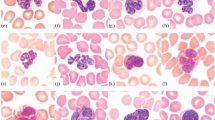Summary
The ultrastructure of liver cells was studied in three groups of bats (Myotis myotis) captured in March. 1. Hibernating animals: The liver cells contain much glycogen and large mitochondria, poorly developed ER, relatively well developed Golgi apparatus, various amounts of lysosomes. Most of the bile canaliculi are closed. 2. Non-hibernating, starving animals: 24 hours after arousal the glycogen and lipid droplets disappear from the liver cells, the mitochondria swell slightly. There is no essential alteration in the ER. In the liver cells of the starving animals numerous autophagic vacuoles appear including disintegrated cytoplasmic components. 3. Non-hibernating force-fed animals: They were given food rich in fat and protein, containing sugar and a drug increasing bile secretion. Within an hour, glycogen and lipid reappears in the liver cells, autophagic vacuoles disappear, mitochondria become larger. After feeding, the Golgi apparatus hypertrophies considerably, many bile canaliculi open, the number of the peribiliary lysosomes decreases.
Similar content being viewed by others
References
Ashford, T. P., and K. R. Porter: Cytoplasmic components in hepatic cell lysosomes. J. Cell Biol. 12, 198–202 (1962).
Caesar, R.: Elektronenmikroskopischer Nachweis von Fettpartikeln im Disseschen Raum. Z. Zellforsch. 54, 793–802 (1961).
Cossel, L.: Die menschliche Leber im Elektronenmikroskop. Jena: Gustav Fischer 1964.
—, u. F. Wohlrab: Die Leber der Fledermaus in Hibernation. Licht- und elektronenmikroskopische Untersuchungen. Z. Zellforsch. 62, 608–634 (1964).
David, H.: Die Regeneration der Leber nach absolutem Hunger. Z. ges. inn. Med. 16, 393–406 (1961).
Deams, W. Th.: The micro-anatomy of the smallest biliary pathways in mouse liver tissue. Acta anat. (Basel) 46, 1–24 (1961).
de Duve, C.: General properties of lysosomes. The lysosome concept. In: Ciba Fondation sym. posium on lysosomes, edit, by A. V. S. de Reuck and M. P. Cameron. London: J. A. Churchill, Ltd. 1963.
Dodgen, C. L., and F. R. Blood: Energy sources in the bat during hibernation and dehibernation. Amer. J. Physiol. 179, 631 (1954).
Essner, E., and A. B. Novikoff: Human hepatocellular pigments and lysosomes. J. Ultrastruct. Res. 3, 374–391 (1960).
— —: Localization of acid phosphatase activity in hepatic lysosomes by means of electron microscopy. J. biophys. biochem. Cytol. 9, 773–784 (1961).
— —: Cytological studies on two functional hepatomas. Interrelations of endoplasmic reticulum, Golgi apparatus and lysosomes. J. Cell Biol. 15, 289–312 (1962).
Farquhar, M., and G. Palade: Junctional complexes in various epithelia. J. Cell Biol. 17, 375–412 (1963).
Fawcett, D. W.: Observations on the cytology an electron microscopy of hepatic cells. J. nat. Cancer Inst. 15, Suppl. 1475–1503 (1955).
Holt, S. J., and R. M. Hicks: The localization of acid phosphatase in rat liver cells as revealed by combined cytochemical staining and electron microscopy. J. biophys. biochem. Cytol. 11, 47–66 (1961).
Jacob, M.: Thèse doctorat és sciences, Strasbourg, 1953, vol. 1, p. 203. Ref. J. D. Weill et Ch. Kayser. C. R. Soc. Biol. (Paris) 151, 374–377 (1957).
Kayser, Ch.: The physiology of natural hibernation. Oxford-London-New York-Paris: Pergamon Press. 1961.
Leonard, S. L., and W. A. Wimsatt: Phosphorylase and glycogen levels in skeletal muscle and liver of hibernating and nonhibernating bats. Amer. J. Physiol. 197, 1059–1062 (1959).
Miller, F., and G. E. Palade: Lytic activities in renal protein absorption droplets. An electron microscopical cytochemical study. J. Cell Biol. 23, 519–552 (1964).
Millonig, G.: The advantages of a phosphate buffer for OsO4 solutions in fixation. J. appl. Phys. 32, 1637 (1961).
—, and K. R. Porter: Structural elements of rat liver cells involved in glycogen metabolism. Proc. of the europ. regional conf. on electron microscopy, Delft 1960, vol. 2, p. 655–659, edit. by A. L. Houwink and B. J. Spit. Delft: De Nederlandske Vereniging voor Electronmicroscopie 1960.
Novikoff, A. B.: Mitochondria (Chondriosomes). In: The cell, biochemistry, physiology, morphology, edit. by J. Brachet and A. E. Mirsky, vol. II, p. 299–421. New York and London: Academic. Press 1961a.
—: Lysosomes and related particles. In: The cell, biochemistry, physiology, morphology, edit. by J. Brachet and A. E. Mirsky, vol II, p. 423–488. New York and London: Academic Press 1961b.
—, and E. Essner: Cytolysomes and mitochondrial degeneration. J. Cell Biol. 15, 140–146 (1962).
Poche, R.: Elektronenmikroskopische Untersuchungen zur Morphologie der Herzmuskel vom Siebenschläfer während des aktiven und des lethargischen Zustandes. Z. Zellforsch. 50, 332–360 (1959).
Popper, H., F. Schaffner, E. Rubin, T. Barka, and F. Paronetto: Mechanisms of intrahepatic cholestasis in drug-induced hepatic injury. Ann. N. Y. Acad. Sci. 104, 988–1013 (1963).
Porter, K. R., and C. Bruni: An electron microscope study of the early effects of 3′-Me-DAB on rat liver cells. Cancer Res. 17, 997–1009 (1959).
Rouiller, Ch.: Les canalicules biliaires. Etude au microscope électronique. Acta anat. (Basel) 26, 94–109 (1956).
—: Contribution de la microscopie électronique à l'étude du foie normal et pathologique. Ann. Anat. path. 2, 548–561 (1957).
—, and W. Bernhard: Microbodies and the problem of mitochondrial regeneration. J. biophys. biochem. Cytol. 2, 355–360 (1956).
—, et G. Simon: Contribution de la microscopie électronique au progrés de nos connaissances en cytologie et en histo-pathologie hépatique. Rev. Int. Hépat. 12, 167–206 (1962).
Steiner, J. W., and C. M. Baglio: Electron microscopy of the cytoplasm of parenchymal liver cells in α-naphthyl-isothiocyanate-induced cirrhosis. Lab. Invest. 12, 765–790 (1963).
Troyer, R. J.: Histochemical and biochemical studies in a hibernator, Myotis lucifugus lucifugus. J. cell. comp. Physiol. 54, 11–23 (1959).
Author information
Authors and Affiliations
Additional information
This paper is dedicated to Professor W. Bargmann on the occassion of his 60th birthday.
Rights and permissions
About this article
Cite this article
Törö, I., Virágh, S. The fine structure of the liver cells in the bat (Myotis myotis) during hibernation, arousal and forced feeding. Z.Zellforsch 69, 403–417 (1966). https://doi.org/10.1007/BF00406292
Received:
Issue Date:
DOI: https://doi.org/10.1007/BF00406292




